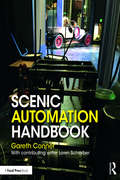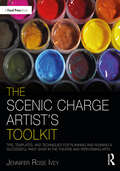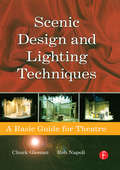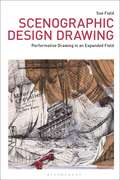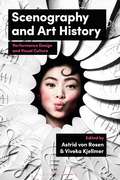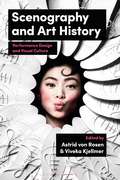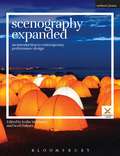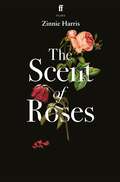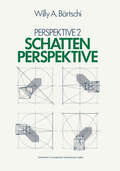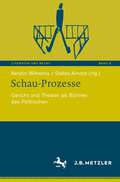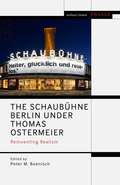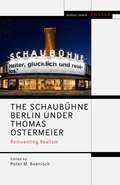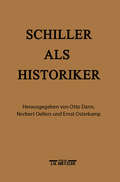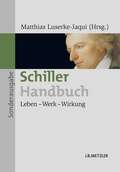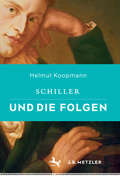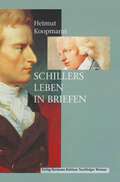- Table View
- List View
Scenic Automation Handbook
by Gareth ConnerScenic automation has earned a reputation of being complicated and cantankerous, a craft best left to the elite of our industry. Not sure of the difference between a VFD, PLC, or PID? If you have dreamed of choreographing scene changes with computerized machinery, but get lost in the technical jargon the Scenic Automation Handbook will guide you along the road to elegant automation. Adopting a pragmatic approach, this book breaks down any automation system into five points, known as the Pentagon of Power. Breaking down a dauntingly complex system into bite- size pieces makes it easy to understand how components function, connect, and communicate to form a complete system. Presenting the fundamental behaviors and functions of Machinery, Feedback Sensors, Amplifiers, Controls, and Operator Interfaces, the Scenic Automation Handbook demystifies automation, reinforcing each concept with practical examples that can be used for experimentation. Automation is accessible – come along and learn how!
The Scenic Charge Artist's Toolkit: Tips, Templates, and Techniques for Planning and Running a Successful Paint Shop in the Theatre and Performing Arts (The Focal Press Toolkit Series)
by Jennifer Rose IveyThe Scenic Charge Artist’s Toolkit is a comprehensive guide to managing a theatrical paint shop. This book introduces the many different options available to a scenic charge artist, as well as the fundamental expectations and responsibilities of planning and running a shop. From the pre-production organization, budgeting, sampling, and sealing, to practical lessons in efficiency and shop maintenance, this text provides options to organize a paint shop no matter the size of the shop, show, or company. Filled with templates for labor and time estimation; tips on leadership and collaboration; techniques for painting and planning textures efficiently; and sustainable practices in health, safety, and wellness, this book provides guidance and practices to successfully manage the inevitable changes in theatre planning and production. It also offers tips and reference material on employment options, gaining employment, and excelling in this profession. Written for early career scenic artists in theatre and students of Scenic Art courses, The Scenic Charge Artist’s Toolkit fills in the gaps of knowledge for scenic artists in the budgeting, planning, and running of shops at summer stock, educational institutions, or freelance working environments. The text includes access to additional online resources such as extended interviews, downloadable informational posters and templates for budgeting and organizing, and videos walking through the use of templates and the budgeting process.
The Scenic Charge Artist's Toolkit: Tips, Templates, and Techniques for Planning and Running a Successful Paint Shop in the Theatre and Performing Arts (The Focal Press Toolkit Series)
by Jennifer Rose IveyThe Scenic Charge Artist’s Toolkit is a comprehensive guide to managing a theatrical paint shop. This book introduces the many different options available to a scenic charge artist, as well as the fundamental expectations and responsibilities of planning and running a shop. From the pre-production organization, budgeting, sampling, and sealing, to practical lessons in efficiency and shop maintenance, this text provides options to organize a paint shop no matter the size of the shop, show, or company. Filled with templates for labor and time estimation; tips on leadership and collaboration; techniques for painting and planning textures efficiently; and sustainable practices in health, safety, and wellness, this book provides guidance and practices to successfully manage the inevitable changes in theatre planning and production. It also offers tips and reference material on employment options, gaining employment, and excelling in this profession. Written for early career scenic artists in theatre and students of Scenic Art courses, The Scenic Charge Artist’s Toolkit fills in the gaps of knowledge for scenic artists in the budgeting, planning, and running of shops at summer stock, educational institutions, or freelance working environments. The text includes access to additional online resources such as extended interviews, downloadable informational posters and templates for budgeting and organizing, and videos walking through the use of templates and the budgeting process.
Scenic Design and Lighting Techniques: A Basic Guide for Theatre
by Rob Napoli Chuck GlomanBasic. This is the key word in Scenic Design and Lighting Tecniques: A Basic Guide for Theatre, written by two seasoned professionals with over twenty years of experience. This book is designed to show you how to turn a bare stage into a basic set design, without using heavy language that would bog you down. From materials and construction to basic props and lighting, this book explains all you will need to know to build your set and light it.
Scenic Design and Lighting Techniques: A Basic Guide for Theatre
by Rob Napoli Chuck GlomanBasic. This is the key word in Scenic Design and Lighting Tecniques: A Basic Guide for Theatre, written by two seasoned professionals with over twenty years of experience. This book is designed to show you how to turn a bare stage into a basic set design, without using heavy language that would bog you down. From materials and construction to basic props and lighting, this book explains all you will need to know to build your set and light it.
Scenographic Design Drawing: Performative Drawing in an Expanded Field (Drawing In)
by Sue FieldThis enlightening study explores the set design drawings for theatre and live performance, highlighting their unique qualities within the greater arena of drawing practice and theory. The latest volume in the Drawing In series, Scenographic Design Drawing encourages an interdisciplinary dialogue in the field of drawing with the inclusion of illustrations throughout.Scenographic design drawings visualize the images in the designer's 'mind's eye' early in the design process. They are the initial design tool in the creative engagement with theatre, opera, dance, and non-text-based performance. It is, in particular, this body of drawings that is unique as both a performative and a theatrical representation of multiple worlds within the 'stage space'. Sue Field illuminates this illustration process and identifies how these drawings have functioned and developed over time.Scenographic Design Drawing serves to satisfy an emerging global curiosity and a thirst for new knowledge and understanding in relation to the drawings executed by the historical and contemporary scenographer. This work addresses a critical research gap and shows how the scenographic design drawing continues to be a principal site of innovation, subjectivity, originality and authorship in theatre and live performance.
Scenographic Design Drawing: Performative Drawing in an Expanded Field (Drawing In)
by Sue FieldThis enlightening study explores the set design drawings for theatre and live performance, highlighting their unique qualities within the greater arena of drawing practice and theory. The latest volume in the Drawing In series, Scenographic Design Drawing encourages an interdisciplinary dialogue in the field of drawing with the inclusion of illustrations throughout.Scenographic design drawings visualize the images in the designer's 'mind's eye' early in the design process. They are the initial design tool in the creative engagement with theatre, opera, dance, and non-text-based performance. It is, in particular, this body of drawings that is unique as both a performative and a theatrical representation of multiple worlds within the 'stage space'. Sue Field illuminates this illustration process and identifies how these drawings have functioned and developed over time.Scenographic Design Drawing serves to satisfy an emerging global curiosity and a thirst for new knowledge and understanding in relation to the drawings executed by the historical and contemporary scenographer. This work addresses a critical research gap and shows how the scenographic design drawing continues to be a principal site of innovation, subjectivity, originality and authorship in theatre and live performance.
Scenography and Art History: Performance Design and Visual Culture
by Astrid von Rosen and Viveka KjellmerScenography and Art History reimagines scenography as a critical concept for art history, and is the first book to demonstrate the importance and usefulness of this concept for art historians and scholars in related fields. It provides a vital evaluation of the contemporary importance of scenography as a critical tool for art historians and scholars from related branches of study addressing phenomena such as witchy designs, Early Modern festival books, live rock performances, digital fashion photography, and outdoor dance interventions. With its nuanced and detailed case studies, this book is an innovative contribution to ongoing debates within art history and visual studies concerning multisensory events. It extends the existing literature by demonstrating the importance of a reimagined scenography concept for comprehending historical and contemporary art histories and visual cultures more broadly. The book contends that scenography is no longer restricted to the traditional space of the theatre, but has become an important concept for approaching art historical and contemporary objects and events. It explores scenography not solely as a critical approach and theoretical concept, but also as an important practice linked with unrecognized labour and broader political, social and gendered issues in a great variety of contexts, such as festive culture, sacred settings, fashion, film, or performing arts. Designed as a key resource for students, teachers and researchers in art history, visual studies, and related subjects, the book, through its cross-disciplinary frame, does consider, implicitly and explicitly, the roles of both scenography and art in society.
Scenography and Art History: Performance Design and Visual Culture
Scenography and Art History reimagines scenography as a critical concept for art history, and is the first book to demonstrate the importance and usefulness of this concept for art historians and scholars in related fields. It provides a vital evaluation of the contemporary importance of scenography as a critical tool for art historians and scholars from related branches of study addressing phenomena such as witchy designs, Early Modern festival books, live rock performances, digital fashion photography, and outdoor dance interventions. With its nuanced and detailed case studies, this book is an innovative contribution to ongoing debates within art history and visual studies concerning multisensory events. It extends the existing literature by demonstrating the importance of a reimagined scenography concept for comprehending historical and contemporary art histories and visual cultures more broadly. The book contends that scenography is no longer restricted to the traditional space of the theatre, but has become an important concept for approaching art historical and contemporary objects and events. It explores scenography not solely as a critical approach and theoretical concept, but also as an important practice linked with unrecognized labour and broader political, social and gendered issues in a great variety of contexts, such as festive culture, sacred settings, fashion, film, or performing arts. Designed as a key resource for students, teachers and researchers in art history, visual studies, and related subjects, the book, through its cross-disciplinary frame, does consider, implicitly and explicitly, the roles of both scenography and art in society.
Scenography Expanded: An Introduction to Contemporary Performance Design (Performance and Design)
by Joslin McKinney Scott PalmerScenography Expanded is a foundational text offering readers a thorough introduction to contemporary performance design, both in and beyond the theatre. It examines the potential of the visual, spatial, technological, material and environmental aspects of performance to shape performative encounters. It analyses examples of scenography as sites of imaginative exchange and transformative experience and it discusses the social, political and ethical dimensions of performance design. The international range of contributors and case studies provide clear perspectives on why scenographic design has become a central consideration for performance makers today.The extended introduction defines the characteristics of 21st-century scenography and examines the scope and potentials of this new field. Across five sections, the volume provides examples and case studies which richly illustrate the scope of contemporary scenographic practice and which analyse the various ways in which it is used in global cultural contexts. These include mainstream theatre practice, experimental theatre, installation and live art, performance in the city, large-scale events and popular entertainments, and performances by and for specific communities.
Scenography Expanded: An Introduction to Contemporary Performance Design (Performance and Design)
by Scott Palmer Joslin McKinney Stephen A. Di BenedettoScenography Expanded is a foundational text offering readers a thorough introduction to contemporary performance design, both in and beyond the theatre. It examines the potential of the visual, spatial, technological, material and environmental aspects of performance to shape performative encounters. It analyses examples of scenography as sites of imaginative exchange and transformative experience and it discusses the social, political and ethical dimensions of performance design. The international range of contributors and case studies provide clear perspectives on why scenographic design has become a central consideration for performance makers today.The extended introduction defines the characteristics of 21st-century scenography and examines the scope and potentials of this new field. Across five sections, the volume provides examples and case studies which richly illustrate the scope of contemporary scenographic practice and which analyse the various ways in which it is used in global cultural contexts. These include mainstream theatre practice, experimental theatre, installation and live art, performance in the city, large-scale events and popular entertainments, and performances by and for specific communities.
The Scent of Roses
by Zinnie HarrisYou'd be surprised how a simple thing like locking up your husband in the same room as you, makes you aware of something. Of being alive.The Scent of Roses begins with a wife who takes her husband hostage in order to have an honest conversation. This simple, transgressive act, and her demand for a straight answer, sparks a chain of conversations, interrogations, obfuscations and revelations, as they and those around them try to discover what is real and who they can trust in a post-truth world.Zinnie Harris's The Scent of Roses premieres at the Royal Lyceum Theatre, Edinburgh, in February 2022.
The Scented Candle Workshop: Creating perfect home fragrance, from wax to wick
by Niko Dafkos Paul FirminIn this beautiful book, Paul and Niko of Earl of East London share the secrets behind the gorgeously scented candles they create at their studio. As well as the basic steps to preparing and pouring candles at home, the book includes a fascinating exploration of the art of building scent, so that the reader can create their own signature fragrances. Paul and Niko are devoted to capturing memories and feelings in scent, and in this book you can learn how to combine different essential oils to trigger different emotions and memories, whether that is the recollection of a childhood holiday conjured up by a hint of mandarin and seaweed, or an imagined walk in your grandparents' garden scented with basil and parsley. Not only is candle making and scent development a wonderfully relaxing craft, it is also a unique way to create personalised gifts or to create a signature scent for your own home or special event.
Schattenperspektive: Perspektive II
by Willy A. BärtschiDas Verständnis des Inhalts dieses Buches setzt die Kennt Kugel durchwegs kreisrund und nicht elliptisch im Umriß nis des Gesichtskreisverfahrens zur Konstruktion von Per wiedergegeben. Es ist ja außerdem so, daß wir uns instink spektiven voraus, das in meinem Buch "Perspektive" ein tiv dagegen sträuben, die Kugel -auch in der Perspektiv- gehend erklärt wird; denn im vorliegenden Buch geht es in der Form eines Ellipsoids darzustellen; denn ein solches um die Darstellung von Schattenperspektiven mit Hilfe des ist keine Kugel und diese ist kein Ellipsoid. Was Wunder, Gesichtskreisverfahrens. daß die Konstruktion der Kugel in der Perspektive in Lehr Während in der Linearperspektive die Dinge linear oder büchern dariiber nicht erklärt wird oder fehlt. Doch gerade bloß durch Linien dargestellt werden, läuft die Schatten dieser Sachverhalt war für mich ein Grund mehr, mich der Lösung dieses Problems besonders anzunehmen. Die Dar perspektive auf die Wiedergabe der gegenständlichen Welt mit Licht und Schatten oder mit hellen und dunklen Ton stellung der Kugel in der Perspektive und damit als Ellip werten hinaus. soid erweist sich aber auch dann als notwendig, wenn es Im 1. Teil dieses Buches werden die beleuchteten Partien darum geht, auf der beleuchteten Oberfläche des geraden der Oberfläche eines Körpers mit dem Papierton, die Ei Kreiskegels und Kreiszylinders die sogenannten Isophoten genschatten mit einem mittleren Grauton und die Schlag und im Zusammenhang damit die Tonstufen zu zeichnen. schatten mit Schwarz - im Ganzen also mit nur 3 Tonwer Dabei ist von der Kugel in der Perspektive auszugehen.
Schau-Prozesse: Gericht und Theater als Bühnen des Politischen (Literatur und Recht #8)
by Kerstin Wilhelms Stefan ArnoldGerichtsprozesse wie der NSU-Prozess haben große mediale Aufmerksamkeit erfahren und sind zum Stoff von zahlreichen Theaterinszenierungen geworden. Solche publikumswirksamen ‚Schau-Prozesse‘ zeigen, wie Gericht und Theater zu Bühnen des Politischen werden. Dabei wird deutlich, dass Recht und Theater viel fundamentaler verbunden sind, als bislang diskutiert: Sie konstituieren sich gegenseitig. Theatrale Elemente sind für das Recht unverzichtbar und umgekehrt prägen Rechtsinszenierungen das Theater. Die Beiträge des interdisziplinären Bandes analysieren diese Wechselseitigkeit und fokussieren die politische Performance im Theater und im Recht.
The Schaubühne Berlin under Thomas Ostermeier: Reinventing Realism (Methuen Drama Engage)
by Edited by Peter M. BoenischOn the 20th anniversary of artistic director Thomas Ostermeier's time at Berlin's Schaubühne Theatre, this important study reflects on the contribution the theatre has made to contemporary theatre, not just in Germany, but around the world. Ostermeier has kept extending and refining the important notion of German Regietheater (directors' theatre) with the Schaubühne Theatre being its internationally famous birthplace under the previous artistic direction of Peter Stein. Through doing so, the work produced at the Schaubühne has transgressed established divides of text-based and devised theatre, and blurred the borders between theatre and dance. Combining scholarly reflection with interview material, this essential collection investigates how theatre has been reinvented by the Schaubühne under Ostermeier's tenure, bringing together international theatre scholars such as Erika Fischer-Lichte, Marvin Carlson, Jitka Goriaux Pelechova, Benjamin Fowler, Ramona Mosse and Sabine Huschka. This study also considers productions by some of Ostermeier's past and present collaborators, such as Katie Mitchell, Falk Richter and Sasha Waltz. This edition also includes the first English translation of Schaubühne's original manifesto “The Mission” (1999); a contribution from Ostermeier's long-term co-director Jens Hillje; a contribution from Hans-Thies Lehmann on Falk Richter; and an interview with Thomas Ostermeier by Clare Finburgh Delijani.
The Schaubühne Berlin under Thomas Ostermeier: Reinventing Realism (Methuen Drama Engage)
On the 20th anniversary of artistic director Thomas Ostermeier's time at Berlin's Schaubühne Theatre, this important study reflects on the contribution the theatre has made to contemporary theatre, not just in Germany, but around the world. Ostermeier has kept extending and refining the important notion of German Regietheater (directors' theatre) with the Schaubühne Theatre being its internationally famous birthplace under the previous artistic direction of Peter Stein. Through doing so, the work produced at the Schaubühne has transgressed established divides of text-based and devised theatre, and blurred the borders between theatre and dance. Combining scholarly reflection with interview material, this essential collection investigates how theatre has been reinvented by the Schaubühne under Ostermeier's tenure, bringing together international theatre scholars such as Erika Fischer-Lichte, Marvin Carlson, Jitka Goriaux Pelechova, Benjamin Fowler, Ramona Mosse and Sabine Huschka. This study also considers productions by some of Ostermeier's past and present collaborators, such as Katie Mitchell, Falk Richter and Sasha Waltz. This edition also includes the first English translation of Schaubühne's original manifesto “The Mission” (1999); a contribution from Ostermeier's long-term co-director Jens Hillje; a contribution from Hans-Thies Lehmann on Falk Richter; and an interview with Thomas Ostermeier by Clare Finburgh Delijani.
Scheduling and Budgeting Your Film: A Panic-Free Guide (American Film Market Presents)
by Paula LandryBudgeting and scheduling are easy in principle but hard in practice. The successful producer has a solid plan for juggling dozens of activities and costs while retaining the flexibility to cope with those inevitable last-minute changes and stay on course. Preplanning the budget and schedule of any media project is absolutely essential, and the 2nd edition of Scheduling and Budgeting Your Film: A Panic-Free Guide shows you the intricacies of handling both budgeting and scheduling successfully. This new and updated edition explains the fundamentals of line producing in an easy-to-understand style, and includes tips and techniques that apply no matter what kind of scheduling or budgeting software you’re using. Author Paula Landry includes detailed examples of breakdown forms, organizing resources, distribution expenses, and hidden costs, and discusses how to set realistic priorities and find industry and state tax incentives. The new edition also includes discussions of transmedia and multi-purpose shooting, special considerations for VR, 4K and 3D shooting, new web platforms and mobile technology, crowd funding, film festivals, and much more. Each chapter is filled with handy checklists, tips, practical advice, and anecdotes, showing how scheduling and budgeting are done in the real world; Principles apply to any type of media project: film, video, music video, projects hosted online, and corporate and educational videos; An accompanying eResources page offers downloadable forms and templates, and other essential resources.
Scheduling and Budgeting Your Film: A Panic-Free Guide (American Film Market Presents)
by Paula LandryBudgeting and scheduling are easy in principle but hard in practice. The successful producer has a solid plan for juggling dozens of activities and costs while retaining the flexibility to cope with those inevitable last-minute changes and stay on course. Preplanning the budget and schedule of any media project is absolutely essential, and the 2nd edition of Scheduling and Budgeting Your Film: A Panic-Free Guide shows you the intricacies of handling both budgeting and scheduling successfully. This new and updated edition explains the fundamentals of line producing in an easy-to-understand style, and includes tips and techniques that apply no matter what kind of scheduling or budgeting software you’re using. Author Paula Landry includes detailed examples of breakdown forms, organizing resources, distribution expenses, and hidden costs, and discusses how to set realistic priorities and find industry and state tax incentives. The new edition also includes discussions of transmedia and multi-purpose shooting, special considerations for VR, 4K and 3D shooting, new web platforms and mobile technology, crowd funding, film festivals, and much more. Each chapter is filled with handy checklists, tips, practical advice, and anecdotes, showing how scheduling and budgeting are done in the real world; Principles apply to any type of media project: film, video, music video, projects hosted online, and corporate and educational videos; An accompanying eResources page offers downloadable forms and templates, and other essential resources.
Scheitern als Performance: Vom Versagen und seiner politischen Relevanz in der Videokunst (Image #198)
by Nicole AlberDas Scheitern ist ein besonders sensibler Punkt im gesellschaftlichen Zusammenspiel. An der Schnittstelle von Kunst- und Sozialwissenschaft sucht Nicole Alber nach seinen Repräsentationen und Bedeutungen in der bildenden Kunst: Ausgewählte Werke der Videoperformance sollen Aufschluss über die politische Dimension von Motiven wie dem Fall oder dem Schiffbruch geben. Dabei wird deutlich: Bas Jan Ader, Cathy Sisler und Francis Alÿs setzen das Scheitern exzessiv, ironisch oder subversiv in Szene, um es radikal zu hinterfragen und inhaltlich neu zu besetzen. Sie ermutigen, das Scheitern anders zu denken, und eröffnen neue Handlungsräume.
Schiller als Historiker
Der Band evaluiert erstmals Friedrich Schillers Leistungen als Historiker im Kontext der Zeit zwischen Aufklärung und Historismus. Er betrachtet dafür das gesamte Werk Schillers.
Schiller-Handbuch: Leben – Werk – Wirkung
Schillers Werk kompakt und verständlich. Das Handbuch stellt neben ausgewählten Gedichten sämtliche Dramen und alle Prosa-Schriften Schillers in detaillierten Werkanalysen vor. Im Mittelpunkt steht der bedeutendste Werkkomplex: die Dramen. Die literatur- und kulturgeschichtlichen Bezüge werden präsentiert und das grundsätzliche anthropologische Interesse des Dichters, Mediziners, Philosophen und Historikers Schiller gewürdigt. Umfangreiche Angaben zur Entstehungs- und Deutungsgeschichte runden die einzelnen Artikel ab.
Schiller und die Folgen
by Helmut KoopmannSchiller gilt als Klassiker eingemauert in das Gefängnis seiner Überzeitlichkeit. Aber kein anderer ist so sehr Zeitgenosse aller Zeiten gewesen wie er. Er hat die Beben der Französischen Revolution vor ihrem Ausbruch gespürt, hat den Aufstand einer jungen Generation gegen die Welt der Väter inszeniert. Kein anderer hat die Freiheit der Kunst so vehement verteidigt und der bürgerlichen Scheinmoral so sehr ins Gewissen geredet. Für Nietzsche war er ein Moraltrompeter . Aber der Weltbürger, der keinem Fürsten dient , hat wie kaum ein anderer die deutsche Kultur und deren Werte mitgeprägt. Das zeigt dieses Buch an einer Fülle von Beispielen und Überlegungen zu allen Bereichen der Kultur.
Schillers Leben in Briefen
Eine lebendige, authentische Darstellung von Schillers Leben im Spiegel seiner Korrespondenz mit führenden Zeitgenossen und Freunden. Helmut Koopmann lässt Schiller als kommunikative Persönlichkeit und geradezu freudigen und nie zu erschöpfenden Briefschreiber vor den Augen des Lesers erstehen.
